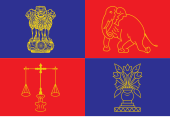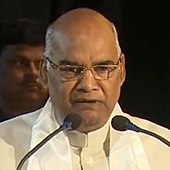President of the Republic of India
| President of India | |

|
|
| Flag of the President of the Republic | |

|
|
|
Acting President Ram Nath Kovind since July 25, 2017 |
|
| Official seat | Rashtrapati Bhavan (House of the President) |
| Term of office | five years (unlimited re-election possible) |
| Creation of office | January 26, 1950 |
| Last choice | 17th July 2017 |
| Deputy | Vice President |
| website | presidentofindia.nic.in (en) |
The President of the Republic of India is the head of state of India . He is formally at the head of the Union government ( executive ) and the two chambers of parliament ( legislative ). Its executive powers are exercised through the Prime Minister and the Cabinet .
history
After independence in 1947, the British monarch (at the time George VI ) remained head of state of the Indian Dominion . India adopted the form of a parliamentary Federal Republic in November 1949 , with a prime minister at the head of the government and a state president as head of state with predominantly representative tasks . The Republican Constitution came into effect on January 26, 1950, now a national holiday in India .
Of all previous presidents, Rajendra Prasad was the longest in office at twelve. Pratibha Patil was the first and so far only female president of India from 2007 to 2012.
Area of responsibility
The President represents India internally and externally. He is the commander in chief of the armed forces . He appoints the Prime Minister, Ministers, State Supreme Court and High Court Justices , Attorney General, State Governors, Chief Election Commissioner , and others in accordance with the provisions of the Constitution has the right to convene or adjourn parliamentary sessions and to dissolve the Lok Sabha and thus to order new elections. He can declare a state of emergency and issue pardons or pardons. There is no limit to the term of office, ie the president can be re-elected as often as desired.
choice
The president is elected indirectly by the people through the two houses of parliament and the chambers of representatives of the states and the union territories of Delhi and Puducherry . The Electoral College ("Electoral College"), with a total of 4,896 members, meets every five years. Not all of them vote in the same place, but their voting weights are added together. The candidate who receives half of the total votes cast is considered elected.
Eligible are persons who in principle meet the requirements for eligibility for the Lok Sabha (e.g. who have no criminal record), who are Indian citizens and are at least 35 years old. At the time of the election, the president may not exercise any state office or must resign from it in order to be eligible for election. The only exceptions to this are the office of president or vice-president, ministerial offices in the Indian central government or a state government or government offices in the states.
Term of office
The regular term of office is 5 years. In the event of inability to work or the premature termination of office, the Vice President takes over the office. If the Vice-President also resigns, the presiding judge of the Supreme Court takes over . Regardless of this, the date of the handover remains July 25th.
residence
The residence of the President is the Rashtrapati Bhavan in New Delhi . He owns other properties near Shimla and in Hyderabad .
See also
Individual evidence
- ↑ a b ELECTION TO THE OFFICE OF PRESIDENT OF INDIA: Frequently Asked Questions. Indian Election Commission, 2012, accessed February 21, 2017 .